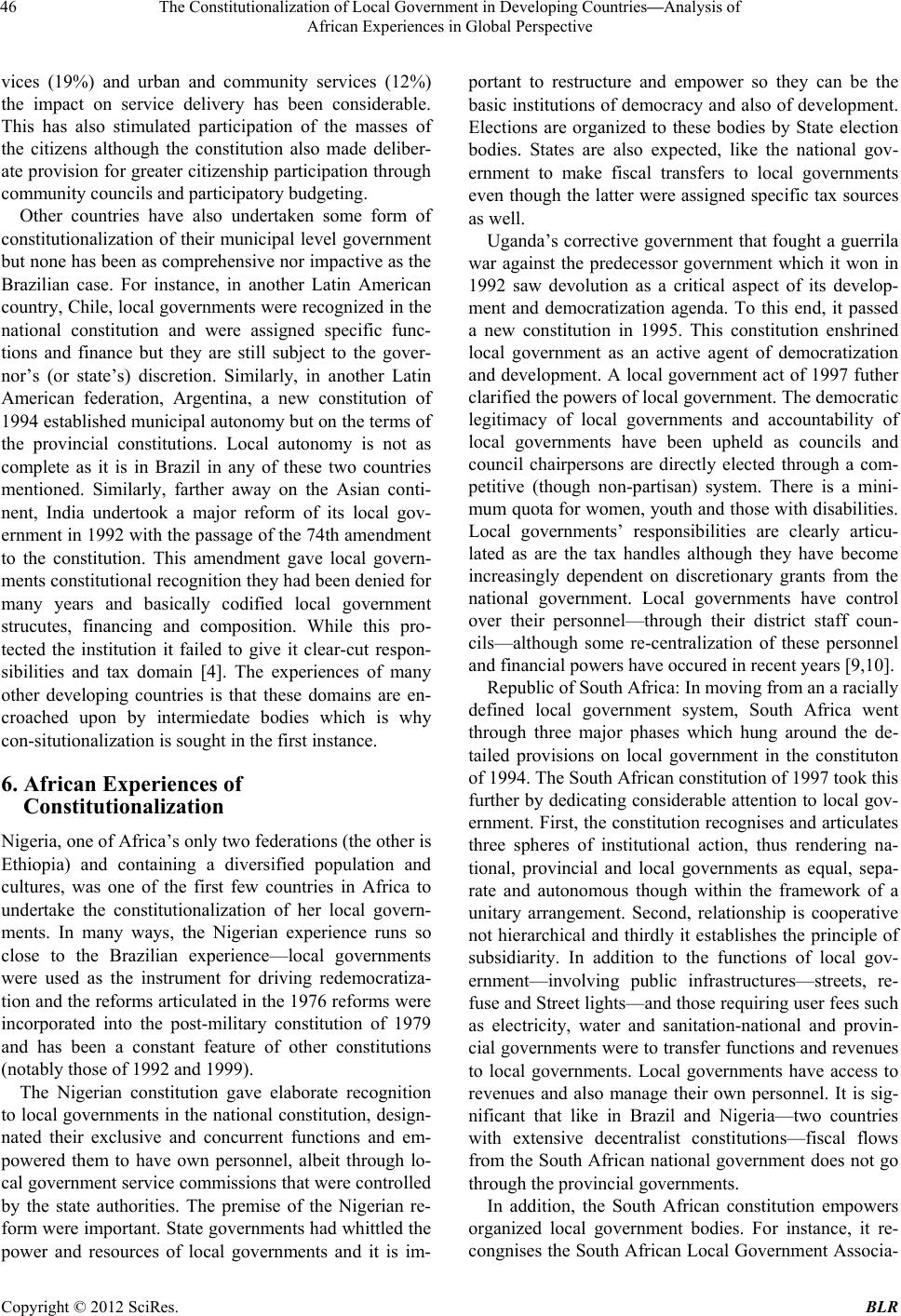
The Constitutionalization of Local Government in Developing Countries—Analysis of
African Experiences in Global Perspective
46
vices (19%) and urban and community services (12%)
the impact on service delivery has been considerable.
This has also stimulated participation of the masses of
the citizens although the constitution also made deliber-
ate provision for greater citizensh ip participation thro ugh
community councils and participatory budgeting.
Other countries have also undertaken some form of
constitutionalization of their municipal level government
but none has been as comprehensive nor impactive as th e
Brazilian case. For instance, in another Latin American
country, Chile, local governments were recognized in the
national constitution and were assigned specific func-
tions and finance but they are still subject to the gover-
nor’s (or state’s) discretion. Similarly, in another Latin
American federation, Argentina, a new constitution of
1994 established municipal autonomy but on the terms of
the provincial constitutions. Local autonomy is not as
complete as it is in Brazil in any of these two countries
mentioned. Similarly, farther away on the Asian conti-
nent, India undertook a major reform of its local gov-
ernment in 1992 with the passage of the 74th amendment
to the constitution. This amendment gave local govern-
ments constitution al recognition th ey had been denied for
many years and basically codified local government
strucutes, financing and composition. While this pro-
tected the institution it failed to give it clear-cut respon-
sibilities and tax domain [4]. The experiences of many
other developing countries is that these domains are en-
croached upon by intermiedate bodies which is why
con-situtionalization is sou ght in the first instance.
6. African Experiences of
Constitutionalization
Nigeria, one of Africa’s only two federations (the other is
Ethiopia) and containing a diversified population and
cultures, was one of the first few countries in Africa to
undertake the constitutionalization of her local govern-
ments. In many ways, the Nigerian experience runs so
close to the Brazilian experience—local governments
were used as the instrument for driving redemocratiza-
tion and the reforms articulated in the 1976 reforms were
incorporated into the post-military constitution of 1979
and has been a constant feature of other constitutions
(notably those of 1992 and 1999).
The Nigerian constitution gave elaborate recognition
to local governments in the nation al constitution, design-
nated their exclusive and concurrent functions and em-
powered them to have own personnel, albeit through lo-
cal government service commissions that were controlled
by the state authorities. The premise of the Nigerian re-
form were important. State governments had whittled the
power and resources of local governments and it is im-
portant to restructure and empower so they can be the
basic institutions of democracy and also of development.
Elections are organized to these bodies by State election
bodies. States are also expected, like the national gov-
ernment to make fiscal transfers to local governments
even though the latter were assigned specific tax sources
as well.
Uganda’s corrective government that fought a guerrila
war against the predecessor government which it won in
1992 saw devolution as a critical aspect of its develop-
ment and democratization agenda. To this end, it passed
a new constitution in 1995. This constitution enshrined
local government as an active agent of democratization
and development. A local government act of 1997 futher
clarified the powers of local government. The democratic
legitimacy of local governments and accountability of
local governments have been upheld as councils and
council chairpersons are directly elected through a com-
petitive (though non-partisan) system. There is a mini-
mum quota for women, youth and those with disabilities.
Local governments’ responsibilities are clearly articu-
lated as are the tax handles although they have become
increasingly dependent on discretionary grants from the
national government. Local governments have control
over their personnel—through their district staff coun-
cils—although some re-centralization of these personnel
and financial powers have occured in recent years [9,10].
Republic of South Africa: In moving from an a racially
defined local government system, South Africa went
through three major phases which hung around the de-
tailed provisions on local government in the constituton
of 1994. The South African constitu tion of 1997 took th is
further by dedicating considerable attention to local gov-
ernment. First, the constitution recogn ises and articulates
three spheres of institutional action, thus rendering na-
tional, provincial and local governments as equal, sepa-
rate and autonomous though within the framework of a
unitary arrangement. Second, relationship is cooperative
not hierarchical and thirdly it establishes the principle of
subsidiarity. In addition to the functions of local gov-
ernment—involving public infrastructures—streets, re-
fuse and Street lights—and those requiring user fees such
as electricity, water and sanitation-national and provin-
cial governments were to transfer functions and revenues
to local governments. Local governments have access to
revenues and also manage their own personnel. It is sig-
nificant that like in Brazil and Nigeria—two countries
with extensive decentralist constitutions—fiscal flows
from the South African national government does not go
through the pro vincial governments.
In addition, the South African constitution empowers
organized local government bodies. For instance, it re-
congnises the South African Local Government Associa-
Copyright © 2012 SciRes. BLR